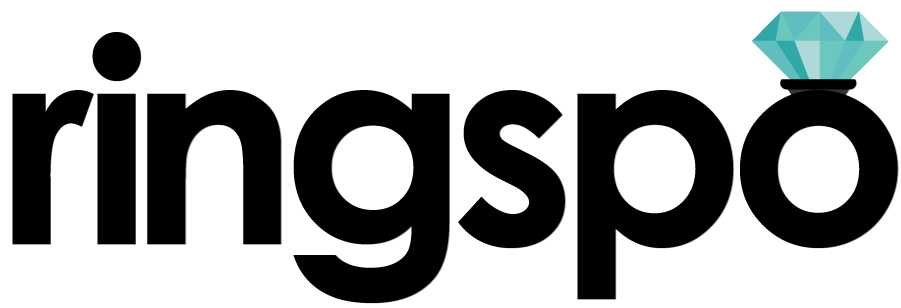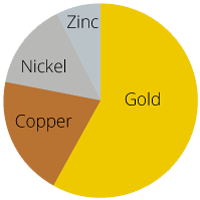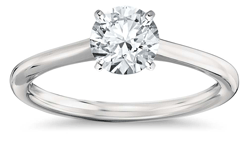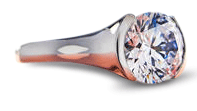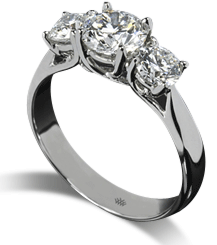[fullwidth_text alt_background=”alt-two” el_class=”mt0 no-arrow reduced-column” width=”1/1″ el_position=”first last”]
White gold is a relatively new invention, in the world of jewelry. A whippersnapper, if you will.
While normal yellow gold-colored gold has been prized and worn for literally thousands of years, white gold has only popped its head up in the last 60. Despite this, it’s now the most popular metal for engagement rings, offering a great mix of beauty, toughness (important in a ring that’s going to be worn every day) and value.
[one_half]
On this page we’ll take a look at:
- A bit of technical info about white gold engagement rings (I’ll keep it brief, I promise)
- What’s good about white gold engagement rings
- What’s not so good
- A selection of rings to check out
At the end of this page you will have a really good idea of what to look for with a white gold engagement ring and some inspiration for some great ring settings styles too.
[/one_half]
[one_half_last][sf_iconbox image=”fa-question-circle” character=”” color=”icon-two” type=”boxed-four” title=”Not sure which color to get?” animation=”none” animation_delay=”200″ link=”” target=”_self”]
If you’re a guy and you’re not sure whether to get a yellow gold or a white-colored engagement ring, the easiest way to tell is to check out your better half’s jewelry box.
If the majority of the jewelry is yellow gold, then stick with it. But, if the majority of her jewelry is silver or white gold, then consider white gold or platinum for your ring.
[/sf_iconbox][/one_half_last]
[/fullwidth_text] [fullwidth_text alt_background=”none” el_class=”mt0 reduced-column” width=”1/1″ el_position=”first last”]
So what is white gold?
[three_fourth]
First up, a bit of background knowledge on gold itself, and how it’s used in jewelry.
Gold is a soft metal, so it’s very rarely found in 100% pure form, other than gold ingots which are generally locked up in bank vaults or hidden under the bed of grannies who don’t trust banks. If you took one of the bricks from Fort Knox and pressed into it with your thumbnail, you would be able to leave a mark.
To make gold strong enough for jewelry that is going to be worn every day, it’s combined with different metals to add strength. There are a few different combinations of alloys that are used to make jewelry-grade gold, and the proportion of gold in the allow gives us the ‘karat’ system.
[/three_fourth]
[one_fourth_last]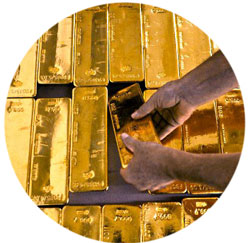
100% pure gold has 24 parts out of 24 made out of gold. Other commons karat grades that are used in jewelry are:
- 9 karat = 9/24 = 37.50% pure gold
- 10 karat = 10/24 = 41.7% pure gold
- 14 karat = 14/24 = 58.3% pure gold
- 18 karat = 18/24 = 75.00% pure gold
- 24 karat = 24/ 24 = 100% gold
Karats are sometimes shortened to kt, or just k, and shouldn’t be confused with the confusingly similarly named ‘carats’ which is the measure of weight for diamonds.
[two_third]The other metals that make up the rest of the white gold alloy will vary, but for 14kt White Gold it would typically be something like 58.5% Gold, 20% Copper, 14.5% Nickel, and 7.5% Zinc, with the nickel and the zinc giving the metal a white color.
White gold is also given a very thin covering of Rhodium, another white coloured metal, which makes it even whiter and also makes the ring hard and tougher. Rhodium is very white, reflective, extremely hard and doesn’t tarnish easily, which makes it the perfect for providing a protective covering for a white gold engagement ring.[/two_third]
[one_third_last]
[/one_third_last]
So where did white gold come from?
Up until WWII, most ‘white’ colored engagement rings were made out of platinum. Silver was never suitable because it tarnished too easily and was too soft for everyday wear, while platinum’s hardiness made it a great material.
But platinum isn’t just good for making ewellery with, it’s also useful for the military, so in WWII the world’s platinum supply got diverted to the military and jewelers needed to find an alternative.
White gold was that alternative and because of its low price compared to platinum, it has stayed popular ever since.
9 karat, 14 karat, 18 karat.. Which is best?
In the USA, you’ll often have a choice of 14kt or 18kt gold for your ring, while in the UK and Australia 9kt is often given as an alternative to 18kt.
Lower karat rings contain less gold which makes them significantly less expensive and therefore more popular. In fact, about 90% of gold rings sold in the US are 14kt gold rather than 18kt.
The higher gold percentage in 18kt gold rings makes them softer than golds with lower kt ratings, which means that they are more likely to be bent out of shape. However, 14kt gold is harder and more brittle than 18kt gold. The difference between the two isn’t huge, but 14kt gold is sometimes used over 18kt for very delicate ring designs, to stop fine detail getting bent out of shape.
[/fullwidth_text] [spb_parallax parallax_type=”image” bg_image=”14246″ bg_type=”cover” parallax_video_height=”content-height” parallax_video_overlay=”none” parallax_image_height=”content-height” parallax_image_movement=”fixed” parallax_image_speed=”0.5″ padding_horizontal=”15″ alt_background=”none” width=”1/1″ el_position=”first last”]
What’s good about white gold engagement rings?
[/spb_parallax] [fullwidth_text alt_background=”none” el_class=”mt0 mb0 no-arrow pb0 reduced-column” width=”1/1″ el_position=”first last”]
Durable
Gold is perfect for jewelry because as well as looking great, it’s it won’t tarnish, rust or corrode, no matter what you throw at it. Adding other metals into the mix in the alloys used in jewelry can affect this a little bit, but in general you can treat gold pretty harshly and it will still look good.
Flexible
Gold is also extremely malleable and flexible. You can apply considerable pressure to and they will just bend, rather than snapping like other, more brittle metals.
In fact,the higher the gold content, the more resilient the ring will be. So an 18k gold ring is a safer bet than a 14 karat one, which is in turn better than a 9k ring.
This malleability also makes it easier for jewelers to work on gold, which results in a higher number of ring styles available, as well as the possibility to create more intricate shapes. Being easier to work with also cuts down the cost of workmanship and actually making the ring, and this lower cost can then be passed on to the end user. That’s you.
Complements diamonds
[two_third]
White gold is particularly suited to diamonds that are on the higher end of the color scale ie. D to H. It will reflect and enhance the fire and brilliance of the sparkle. The neutral tones of white gold will work with any gem color though. It looks equally excellent with sapphire, diamond, ruby or anything else.
White gold is relatively easy to get back to a brilliant shine, if time has taken its toll and your ring is no longer quite as dazzling as it once was. But, care does need to be taken, as we’ll find out in the next section.
[/two_third]
[one_third_last]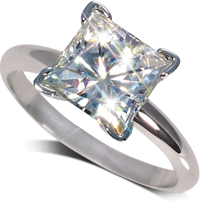
Cost effective
And the very last point, and it’s a biggie, is that gold is much less expnsive than platinum. Exactly how much cheaper depends on which karat of gold you go with, but it can be ¼ of the price of platinum, which is definitely not to be sniffed at. Check out these comparisons:
[one_half]
Solitaire engagement ring setting
14k white gold: $180
18k white gold: $530
Platinum: $710
[/one_half]
[one_half_last]
Pavé halo engagement ring setting
14k white gold: $2,050
18k white gold: $2,320
Platinum:$2,840
[/one_half_last]
[/fullwidth_text] [spb_parallax parallax_type=”image” bg_image=”14260″ bg_type=”cover” parallax_video_height=”content-height” parallax_video_overlay=”none” parallax_image_height=”content-height” parallax_image_movement=”fixed” parallax_image_speed=”0.5″ padding_horizontal=”15″ alt_background=”none” width=”1/1″ el_position=”first last”]
What’s not so good about white gold engagement rings?
[/spb_parallax] [fullwidth_text alt_background=”none” el_class=”mt0 mb0 reduced-column” width=”1/1″ el_position=”first last”]
White gold isn’t perfect though, and a few of the good points actually have a negative flipside.
Rhodium wears off
White gold is easy to polish back up to a brilliant shine, but if you’re a bit over-enthusastic with the elbow grease or you use too rough a cloth to do the polishing then you will polish off the top layer of rhodium, exposing the actual colour of the gold underneath.
[one_half]Rhodium wearing away is actually inevitable and there is nothing that you can do to prevent it. Everyday wear and tear will mean that the underling colour will start to show through after a couple of years. If you’re especially careful then you can probably stretch it out to 5 years without needing to replate it, but eventually you will need to pay a jeweler to reapply the rhodium plating. This may set you back between $30 – $50. Not a huge expensive in the grand scheme of the cost of an engagement ring, but it’s definitely something to bear in mind.[/one_half]
[one_half_last]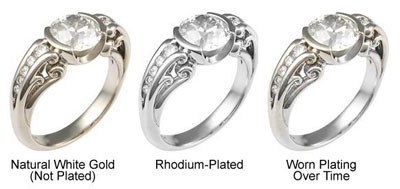
Scratches
Anything that is harder than gold will scratch it, so engagement rings do need to be looked after a little. Platinum is most definitely harder than white gold, so the number one rule with matching a wedding ring to an engagement ring is to make sure that they are made of the same material, so one doesn’t wear the other down and they age at the same rate.
Allergies
Gold itself is naturally hypoallergenic ie. it won’t irritate the skin. But, as we learnt earlier, the gold used in jewelry is an alloy and some of the metals used in the alloy can cause people to have allergic reactions. The most likely culprit for this is nickel, which about 10% of people are allergic to.
If someone already wears gold or white gold jewelry, it’s pretty safe to say that this isn’t an issue for them.
‘Warmer’ diamonds
Lastly, while a white gold ring is great to complement a diamond that is graded high on the colour scale (D – H), for ‘warmer’ ie. more yellow colours, a white gold setting may actually make the stone look more yellow due to the contrast between the bright white of the metal and the color of the stone.
All of these negatives are more just things to keep in mind when buying a white gold engagement ring. There is no perfect metal to create an engagement ring out of and for the balance of beauty, durability and good looks, white gold is a great choice.
[/fullwidth_text] [spb_parallax parallax_type=”image” bg_image=”14262″ bg_type=”cover” parallax_video_height=”content-height” parallax_video_overlay=”none” parallax_image_height=”content-height” parallax_image_movement=”fixed” parallax_image_speed=”0.5″ padding_horizontal=”15″ alt_background=”none” width=”1/1″ el_position=”first last”]
White gold engagement ring settings
[/spb_parallax] [fullwidth_text alt_background=”none” el_class=”reduced-column” width=”1/1″ el_position=”first last”]
While it’s important to get the best center stone that you can for you ring, it’s the ring setting that really defines the character of the ring.
This list below is by no means definitive, but it’s a representation of some of the different styles of white gold engagement rings that are available. If you see a setting you like, click through to find out more and check out the other white gold setting styles that each jeweler offers too.
[one_fourth]
[/one_fourth]
[one_half]
The classic solitaire is the best selling engagement ring by far, year after year. Its combination of elegant design and low cost due to simplicity is hard to beat.
Pictured are the traditional 4 prong setting and the ‘Tiffany-style’ 6 prong setting in white gold. Click the pics to find out more.
[/one_half]
[one_fourth_last]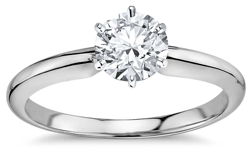
[two_third]Bezel engagement rings are a great choice for those with an active lifestyle: the protective bezel around the delicate edge of the diamond protects it from getting chipped or damaged. Bezel engagement rings are also very well priced due to their simplicity and the lower amount of white gold used compared to more extravagant designs.
[/two_third]
[one_third_last]
[one_third]
[/one_third]
[two_third_last]Full bezel settings can limit the amount of light that enters a diamond, meaning that they sparkle less than they should.
This ‘half bezel’ has the benefit of protecting the majority of the diamond, while still allowing a large amount of light to enter the sides of the stone.
14k white gold half bezel engagement ring from Brian Gavin
Check out all settings from Brian Gavin[/two_third_last]
[two_third]Adding some detail to the ring band can make a solitaire engagement ring really stand out. This vintage-inspired option has ‘millgrain’ detailing along the edges of the the ring band and hand-engravins on the top and side.
Vintage-style millgrain solitaire engagement ring from Blue Nile in 14k white gold
Check out all engagement ring settings from Blue Nile[/two_third]
[one_third_last]
[one_third]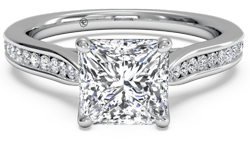
[two_third_last]Adding small diamonds to the ring band can be a great way of increasing the sparkle-factor of your ring without adding too much cost.
This example has 0.14 carats of diamonds set into a channel in the ring band, to ensure that the ring sparkles from whatever direction someone views it from.
Channel set Princess cut solitaire engagement ring from Ritani
Check out all white gold engagement rings at Ritani[/two_third_last]
[two_third]Choosing a setting with more than one diamond means that the center stone doesn’t need to do all of the impressing on its own.
This three stone ring pairs the center stone with two matching round brilliant diamonds, for an additional 0.5 carats of diamonds on top of the center stone.
14k white gold three stone engagement ring from Whiteflash
Check out all Whiteflash engagement ring settings[/two_third]
[one_third_last]
[/one_third_last]
[one_third]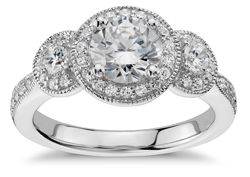
Every ring style has several variations – this three stone ring surrounds each of the three stones with a ‘millgrain’ halo to give a vintage feel. Millgrain is the tiny details that you can see on the edge of each of the halos and is a feature often found on antique engagement rings.
Three stone millgrain engagement ring from Blue Nile
View all engagement ring settings from Blue Nile[/two_third_last]
[one_third]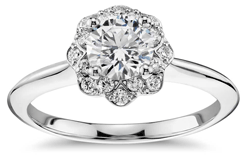
[two_third_last]
Halo settings are another great way to support a center diamond: the width of the halo makes the whole ring look larger.
This examples uses a delicate floral shape for the halo itself, with 16 diamonds set into it.
Floral halo engagement ring from Blue Nile
View all engagement ring settings from Blue Nile[/two_third_last]
[two_third]This innovative halo ring features a delicate ‘crossover’ pavé band, with the ring band crossing behind the wearer’s finger.
There are a huge number of combinations of stone and settings styles when it comes to halo engagement rings – James Allen has 106 different halo settings just in white gold to check out.
Halo engagement ring with twisted pavé shank from James Allen
Check out 106 white gold halo setting options at James Allen
[/two_third]
[one_third_last]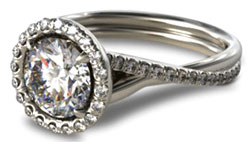
[two_third]The round diamond is the most popular shape for a reason though – no other shape sparkles quite so well. This V-shank pavé halo ring from Ritani will sparkle more than any other ring on this page.
V-shank pavé halo engagement ring from Ritani
Check out all 538 white gold engagement ring options at Ritani[/two_third]
[one_third_last]
[/fullwidth_text] [spb_text_block pb_margin_bottom=”no” pb_border_bottom=”no” el_class=”reduced-column” width=”1/1″ el_position=”first last”]
[/spb_text_block]
